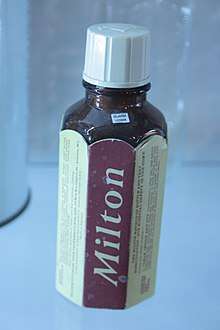Milton sterilizing fluid

Milton sterilizing fluid is produced by Procter & Gamble for sterilization uses. It contains 1% sodium hypochlorite (NaClO) and 16.5% sodium chloride (NaCl; common salt). 1:80 dilution is used to sterilise babies' feeding utensils, including baby bottles. It is sold in dissolvable tablets which are then mixed with cold water and placed in a lidded bucket. This method of bottle sterilization is marketed as "The Milton Method".
A 1:20 solution is isotonic with body fluids. 1:4 dilution is used for wound management applications. This contains 0.25% (w/v) available chlorine and has a pH of 10.5 - 11.2.[1][2]
History
The product and company began in 1916 and was named after the poet John Milton as a "safe" household name. During the First World War it was used on the front to treat burns and skin conditions.[3]
In 1947 a widespread outbreak of gastroenteritis in the UK, causing the death of 4,500 children under the age of one, gave rise to a national objective of sterilising all baby's milk bottles, and Miltons Fluid was the chosen antiseptic of choice advocated by hospitals and government agencies. This cold water method was generally available and simple for all to use, and virtually all mothers adopted this method.[4]